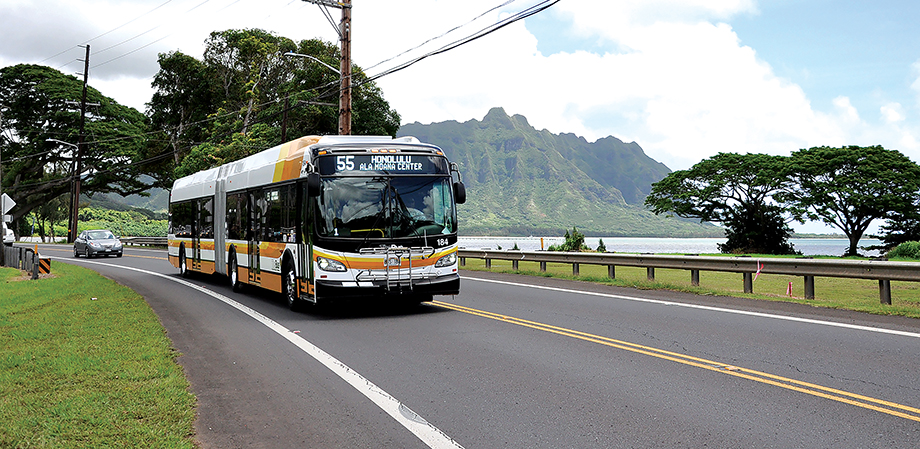
There is nothing worse than your passenger missing their bus due to poor headway spacing. They show up to the stop on time expecting a ride. But, because of bunching, they have no idea their bus has already come and gone or is too full for them to get on. It’s frustrating for them because they don’t get to where they are going on-time. It’s frustrating for you because you’ll hear about the complaints even though external factors like congestion caused the issue.
Headway management is a critical issue in public transportation, directly affecting service times, vehicle bunching, and system-wide consistency. Oahu Transit Services, which serves the busy island of Oahu, Hawaii, wanted to remove the guesswork from headway management, so they turned to Trapeze Group’s Intelligent Transportation Systems (ITS) solution, TransitMaster.
TheBus, operated by Oahu, which employs around 950 operators and another 70 support staff, sometimes has up to 435 vehicles on the road at a single time. Without proper headway management, the island’s busiest routes are subject to vehicle bunching, resulting in long passenger wait times at bus stops and sometimes in missed rides altogether.
“When buses bunch, passengers get passed up,” said Ralph Faufata, vice president of transportation, Oahu Transit Services. “It’s a result of vehicles not running at the times they are supposed to, and we end up with some buses at capacity and others with not enough passengers.”
Two routes, Faufata said, were particularly prone to poor headway spacing. One, a short route in Waikiki, dealt with congestion at varying times due to special events in the area. The other route, travels from Waikiki through downtown Honolulu and is the agency’s busiest in terms of passenger capacity, also had significant issues with bus bunching and customers being passed by at stops.
Developing real-time headway management
The agency partnered with Trapeze Group in 2017 to create a “smart” headway management system. The resulting software, which was deployed for use in 2018, utilizes Trapeze TransitMaster real-time vehicle monitoring to manage headway between buses. The system and its algorithms monitor vehicle locations, real-time traffic feeds, and passenger counts. If one bus is getting too close to a vehicle ahead or is moving too slow, the system automatically provides that feedback to each operator on the route and adjusts the operators’ layover countdown timer to compensate.
“When an operator gets to a layover point, they have a dynamic countdown timer,” said Dmitriy Vanchugov, director of sales, ITS, at Trapeze Group. “The countdown timer is telling them when to go, in order to maintain an optimized travel time spacing on a particular route. The software system is guiding operators without dispatch intervention or the control center doing anything. It’s just the algorithm working to inform that route on how to stay optimally spaced.”
Vanchugov said that the inclusion of real-time traffic data is a big differentiator for this system.
“The system isn’t just measuring distance, but actually measuring travel time based on traffic and distance,” he said. “Previous headway management systems weren’t able to factor those elements to create a ‘travel time,’ and that is why so many of those systems were unsuccessful.”
The system in action
Operator acceptance has been a slow but steady process, Faufata said.
“They like the system because they’re not always trying to chase their tail,” he said. “If traffic is really bad and you have a set schedule, the system makes the necessary adjustments for you.”
“Some of them still have trouble adapting to the new system, because of their years of doing things a certain way,” he added. “But our drivers are definitely making progress. As we watch the system, we can see the gaps developing and call the drivers – reminding them to follow the system so that we can minimize uneven spacing.”
The deployment is still in its early stages, but Faufata said that TheBus has seen a significant drop in the number of pass-up complaints, especially on the high-traffic route that travels through downtown Honolulu. With the optimized spacing, passenger loads are balanced more evenly between vehicles.
Faufata said that the partnership with Trapeze has been collaborative and rewarding, as both sides have contributed to shaping the system into its current form.
“They have been able to give us solutions very quickly, and so we have had a lot of time using the system,” he said. “Once we started using it, we really just let it run and adjusted as needed. And so, it’s developed into the product that it is today.”
“Agencies have been able to track buses on a computer for a long time, but there was never an algorithm taking that information and converting it into instructions for drivers and managers,” Vanchugov added. “It takes system awareness and turns it into action.”
